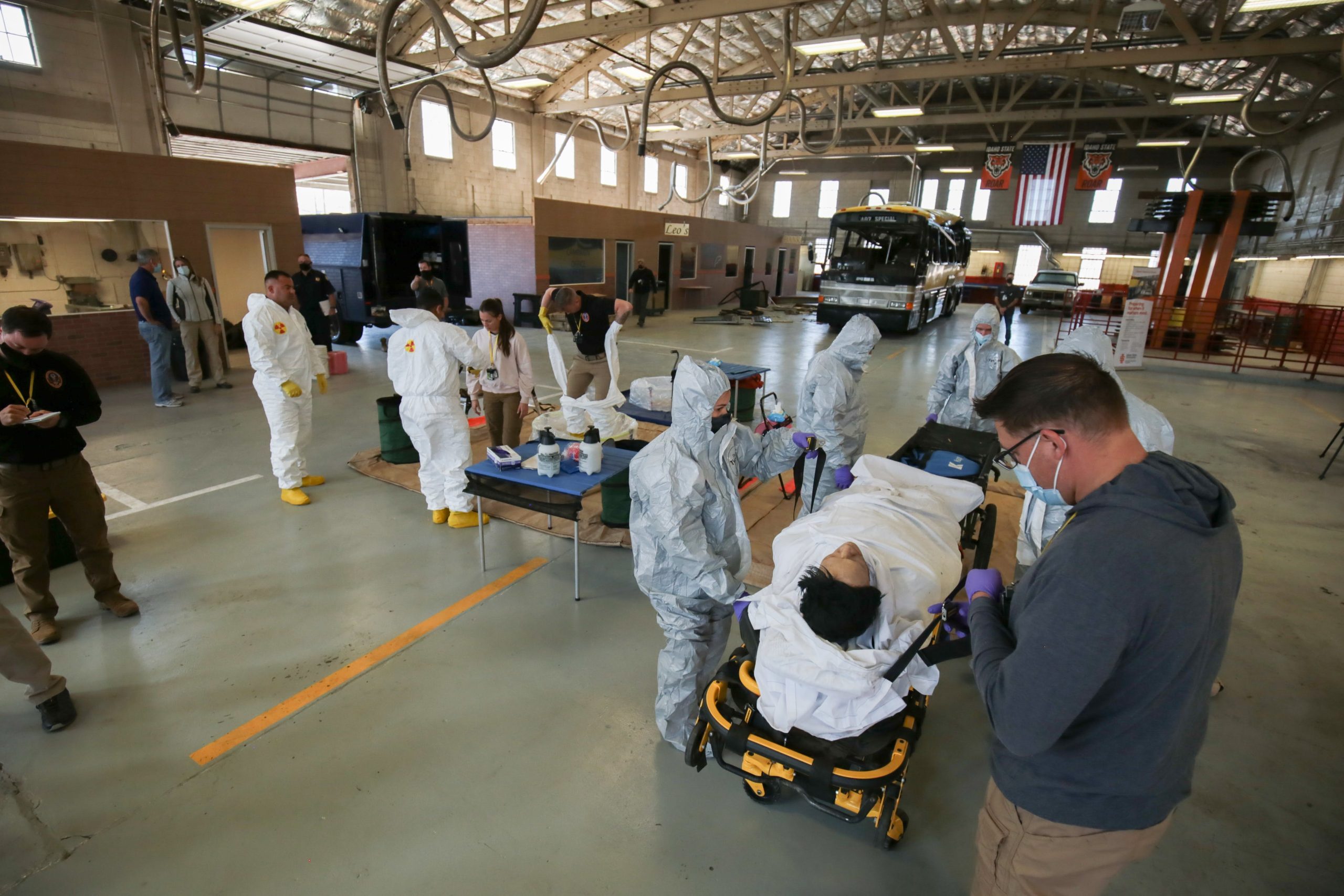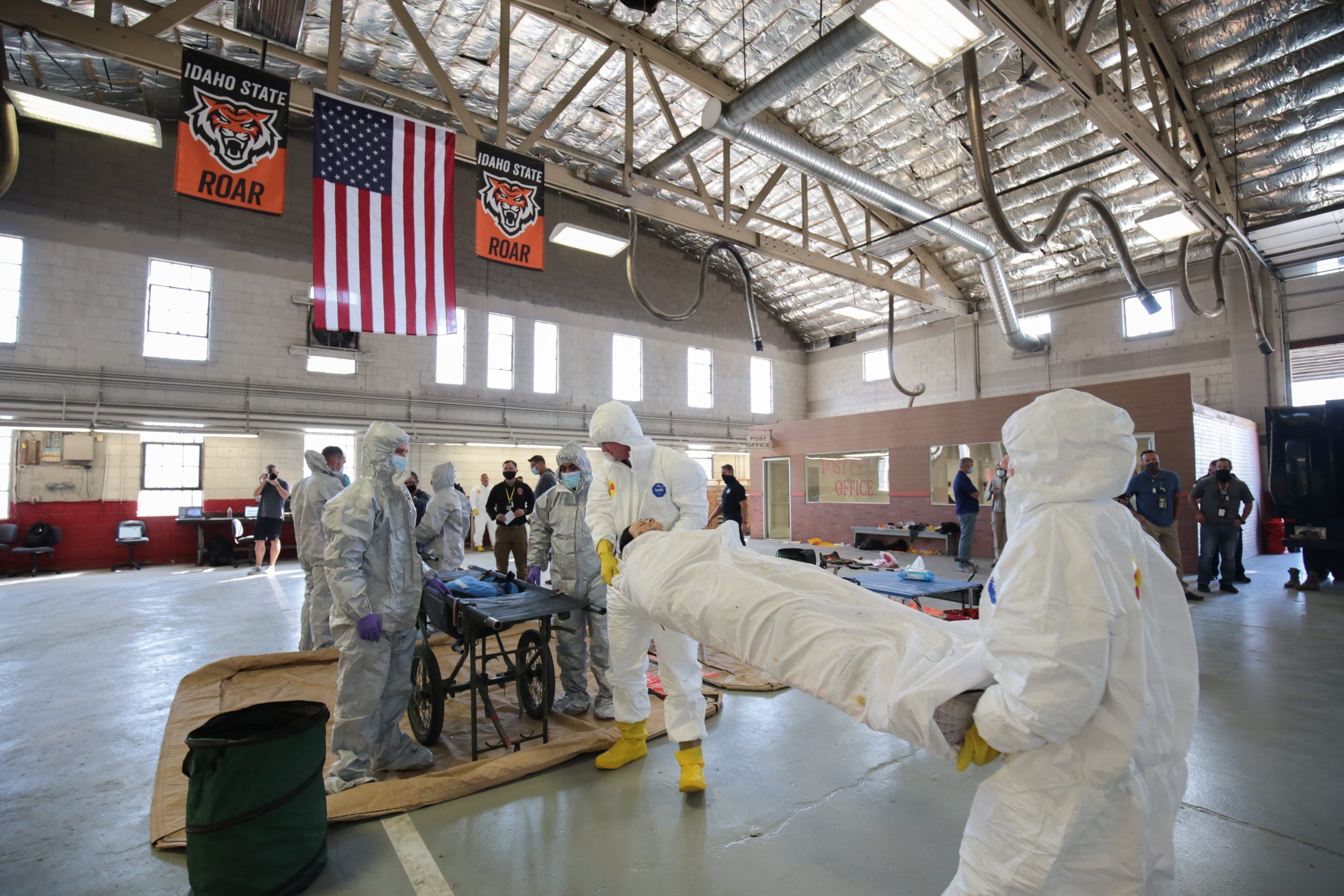When it opened in 1939 and for the next 30 years, Pocatello’s National Guard Armory on South Second Avenue bustled with activity. Guardsmen trained with tanks and armored vehicles, frequently leaving for maneuvers in the hills outside town. But if the walls of the New Deal-era armory could talk, they would tell of dinners and parties, model airplane exhibitions, pro wrestling matches, and rock ‘n’ roll shows.

When it built a new armory near the Pocatello Fairgrounds in 1969, the Guard handed the building over to Idaho State University, which used the facility for its diesel technology program. Today, however, things have come full circle as the armory has entered its third act, as part of ISU’s Disaster Response Complex. As emergency responders from throughout the country come to train, once again the Guard is back.
“It has a rich history,” said Mustafa Mashal, associate professor in ISU’s Department of Civil and Environmental Engineering. As a fellow with the Center for Advanced Energy Studies, of which ISU is a part, Mashal engaged with Idaho National Laboratory’s (INL) National & Homeland Security directorate in 2017, when he learned that the Idaho National Guard was planning to do an exercise at the INL Critical Infrastructure Test Range Complex.
To properly train in response to natural, human-made or terrorist-initiated disasters, the Idaho National Guard requested a collapsed structure. “We needed an engineer to help us design a safe structure and create unique training lanes,” said Bryon Marsh, National Guard training and exercise program manager for INL National & Homeland Security. Mashal, his department chair Bruce Savage, and graduate students Jared Cantrell and Katie Hogarth met with Marsh to discuss how they could build a safe and secure training site that simulated a collapsed structure, albeit one engineered to be safe for training emergency responders. From these discussions, ISU’s Disaster Response Complex was born. For the project, ISU received nearly $1.1 million in a grant from the Higher Education Research Council of the Idaho State Board of Education through the Idaho Global Entrepreneurial Mission.
Armory becomes available

As the outdoor site was being developed at ISU’s Research and Business Park, Mashal learned in 2019 that the ISU Diesel Technology program was moving out of the old armory, and the building was planned to become a storage facility. The old armory, along with the rest of Pocatello’s Old Warehouse District, had been put on the National Register of Historic Places in 1996.
“It was perfect for us,” Mashal said. “In addition to its classrooms, offices and meeting rooms, the basement, the fortified ammunition storages and the 10,500-square-foot high bay area offered superb spaces for a mock city block and controlled simulations. The large parking lot and proximity to the ISU campus and downtown Pocatello only added to its appeal. More importantly, the rich history and the unique dome shape of the high bay area were features that we could not find in other potential spaces around the campus. Also, I was personally interested to revive the old armory so it can serve the community of emergency responders, including National Guard, for many years to come.”

Since setting up at the armory in 2020, ISU has hosted more than a dozen organizations, including military, fire departments, health care professionals, law enforcement, nonprofit search and rescue, and others for practicing their responses to natural and human-made disaster scenarios. Among those groups have been the Weapons of Mass Destruction Civil Support Teams (CSTs) from National Guard units around the country. CSTs are typically called to support large events like the Super Bowl, where the possibility of terrorists attacking with chemical, biological, radiological and nuclear agents is a concern. Across the nation, there are 57 federally sustained, state-controlled CSTs on standby for emergencies. The Idaho National Guard’s CST is based in Boise and consists of 22 soldiers and airmen.
In the fall of 2020, INL approached the Disaster Response Complex team about using the armory’s vehicle bay to set up a staged city block for scenario-based trainings. INL’s Marsh recalls,
“As a retired Army National Guard officer and a former CST deputy commander, I was immediately drawn to the armory and its history. I had access to a decommissioned INL commuter bus and thought it would be perfect as the center piece for the city block training lane.”
ISU agreed and the following spring, INL detonated a small explosive charge inside the bus, resulting in significant damage replicating a terrorist attack. The bus was transported to the armory building and has been used several times to exercise a response to a mass-casualty event. “The soldiers and airmen are connected to the history and appreciate the training opportunities that the [Disaster Response Complex] has to offer,” said Marsh.
“Legacy buildings like the Pocatello armory are great for training,” said Chris Oertel, a former senior scientist with INL who is now retired. “It would cost you a fortune to build something like that today, but because it was once an armory, it was pretty much plug-and-play.”
INL and the Center for Advanced Energy Studies intend to regularly use the facility to develop workforce talent. Oertel said the building is big enough to have two CST units doing search exercises with radiation detection equipment at the same time.
Call for old stories goes out
Curious about the armory’s distant past, Mashal tasked students with collecting stories about the facility. Social media was a handy tool when Mahesh Acharya, an ISU civil engineering student, posted on the Facebook group called You know you grew up in Pocatello when …
“We are actually building a training lane for first responders in this facility, and we are digging in to find out the history of the building,” he wrote. “Any kind of knowledge/memory is really appreciated.”
The response was enthusiastic and varied.
“When I enlisted in the Idaho Army National Guard in 1961, I became a member of Troop H, 2nd Squadron 116 Armored Cavalry Squadron stationed in that building,” said Garry Pritchett of Pocatello. “Second Squadron headquarters and Troop F also were located in the building. At that time, Troop H was equipped with the M48 Patton Main Battle Tank and F troop was equipped with the M41 Walker Bulldog Tank. We often drove our tanks through the ISU campus and practiced driving and combat exercises in the hills above the campus.”
“It was always a big deal watching the convoy come in when they came home,” wrote Kathi Damron Galloway of Pocatello, who was a little girl at the time and whose father was a sergeant in a Guard unit. “I remember … crawling all over the tanks and sometimes getting to ride in the jeeps during parades,” she said. “Occasionally we were allowed to go up where the classrooms were but couldn’t wander around up there much. … Unfortunately, my dad no longer remembers much about that time in his life. Once in a while, someone who was in the Guard with him comes up and greets him as Sgt. Damron.”

Howard Howell lived with his family in a small apartment attached to the armory drill hall. His father was the first sergeant of F Troop and the armory’s caretaker. “I remember helping out by stoking the coal furnace that heated the building,” he said. “I also used to clean up the drill hall after the wrestling matches. … Next-day cleanup after the New Year’s Eve party was my least favorite job. … Big square-dancing events were the best.”
Disaster response came into play in a very real way when the Portneuf River flooded in 1962.
“The armory was the center of activity for flood action both in filling sandbags, building barriers and providing relief for the workers,” said Jacquee Alvord, whose father, Jack Alvord, owned Ford’s Cafe on West Main Street. “He prepared food bags for the workers, including sandwiches, chips and water. Several times, I delivered the food packages and the items to the armory, witnessing dozens of workers under the direction of the Army with city maintenance staff. The work went on for countless hours. It was one of the key events in the history of the armory,” she said.
Of all the pro wrestlers who toured the U.S. in the ‘50s and ‘60s, probably the best known was Gorgeous George, and several respondents mentioned seeing him at the Pocatello armory. “I grew up across the street and watched all the wrestlers drive in together, and then in the ring (they) acted like they were bitter enemies,” said Jo Ann Hofhine of Pocatello, who still has the autograph book that she used to collect their signatures.
Gail Brookins, now of West Fargo, North Dakota, remembers seeing Paul Revere and the Raiders play at the armory in the late ’50s. The Caldwell-based band, which went on to have a string of radio hits in the mid-’60s, was renowned for its antic stage show.
Although it is unlikely that anything quite so memorable is going to happen at the Pocatello armory under the new management, one thing is certain: “ISU has repurposed that building to support the National Guard mission once again,” Marsh said.





